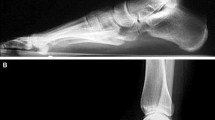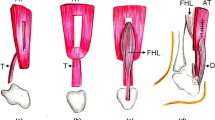Abstract
In a retrospective study, we reviewed our results of treatment of stage II posterior tibial tendon rupture in 129 patients for whom surgery was performed between 1990 and 1997. During this period of time, 148 patients were treated with surgery following failure of nonsurgical methods of treatment. The 129 patients (117 females, 12 males) with an average age of 53 years (range, 34–75 years) had been symptomatic for an average of 2.8 years (range, 0.5–7 years). The indication for surgery was the presence of foot pain, which was refractory to shoe modifications, orthoses, and brace support. All patients had a painful flexible flatfoot without a fixed forefoot supination deformity. The surgery performed included a medial translational osteotomy of the calcaneus and transfer of the flexor digitorum longus tendon into the navicular. There were additional surgeries performed in 49 patients including repair of a tear of the spring ligament, talonavicular capsule or deltoid ligament (45), lengthening of the Achilles tendon (26), correction of hallux valgus deformity (5), and arthrodesis of the first tarsometatarsal joint (4). All patients were examined, radiographs obtained, and isokinetic evaluation of both feet and lower limbs performed with the KinCom apparatus at a mean of 4.6 years following surgery (range, 3–8 years). The AOFAS hindfoot scale was used to evaluate each patient, although, due to the time elapsed from the initiation of treatment, preoperative AOFAS scores were not retrospectively determined. The mean AOFAS score at the time of the follow-up examination was 79 points (range, 54–93). There were 7 significant complications in 6 patients including: significant progressive hindfoot valgus deformity in 1 patient treated with a triple arthrodesis; overcorrection of the hindfoot in 2 patients necessitating revision with a lateral closing wedge calcaneus osteotomy; 3 patients with symptomatic sural neuritis, and 1 patient with weakness of the gastrocnemius resulting from overlengthening of the Achilles tendon. Isokinetic inversion and plantarflexion power and strength were compared with the contralateral limb for 121 patients, and were noted to be symmetric in 95, mildly weak in 18, and moderately weak in 8. Motion of the subtalar joint was normal in 44%, slightly decreased in 51%, and moderately decreased in 5% of patients. Anteroposterior and lateral radiographs were evaluated for the talonavicular coverage angle, talus-first metatarsal angle, talocalcaneal angle, and the height of the medial cuneiform to the floor. For 4 of these 5 parameters evaluated, the correction obtained was statistically significant (p < 0.05). Of the patients examined, 123 were entirely satisfied, 4 partially satisfied, and 2 were dissatisfied with the outcome of the procedure. Most patients experienced pain relief (97%), an improvement of function (94%), noted an improvement in the arch of the foot (87%), and were able to wear shoes comfortably without resorting to shoe modifications or orthotic arch support (84%). In conclusion, the surgical correction of stage II posterior tibial tendon rupture with medial translational calcaneus osteotomy and flexor digitorum longus tendon transfer to the navicular yielded excellent results with minimal complications, and a high patient satisfaction rate.
Résumé
Dans une étude rétrospective, nous avons passé en revue nos résultats du traitement d’une rupture du tendon tibial postérieur de stade II, chez 129 patients opérés, entre 1990 et 1997. Au cours de cette période, 148 patients ont été traités par chirurgie après l’échec des traitements non chirurgicaux. Les 129 patients (117 femmes, 12 hommes), âgés en moyenne de 53 ans (limites: 34–75 ans), présentaient des symptômes depuis 2,8 ans en moyenne (limites: 0,5–7 ans). L’indication de la chirurgie était la présence d’une douleur au pied, réfractaire à la modification des chaussures, aux orthoses et au soutien par attelle. Tous les patients présentaient un affaissement de la voûte plantaire douloureux à la flexion, sans déformation du coup de pied en supination. L’intervention pratiquée consistait en une ostéotomie translationnelle interne du calcanéum et un transfert du tendon fléchisseur commun des orteils sur l’os naviculaire. D’autres actes chirurgicaux ont été pratiqués chez 49 patients, dont une réparation de déchirure du ligament calcanéoscaphoïdien inférieur, de la capsule astragaloscaphoïdienne ou du ligament deltoïdien (45), un allongement du tendon d’Achille (26), une correction d’un hallux valgus (5) et une arthrodèse de la première articulation tarsométatarsienne (4). Cent vingt-neuf patients ont été examinés, des radiographies ont été prises et une évaluation isocinétique des pieds et des membres inférieurs a été réalisée avec l’appareil KinCom, 4,6 ans en moyenne après la chirurgie (limites: 3–8 ans). Chaque patient a été évalué au moyen de l’échelle AOFAS de l’arrière pied, même si, en raison du temps écoulé depuis le début du traitement, les scores AOFAS préopératoires n’ont pas été déterminés rétrospectivement. Le score AOFAS moyen à la date de l’examen de suivi était de 79 points (limites: 54–93). On a recensé sept complications significatives chez six patients, à savoir: déformation progressive de l’arrière pied en valgus chez un patient, traité par triple arthrodèse; surcorrection de l’arrière pied chez deux patients, nécessitant une révision avec ostéotomie cunéiforme de fermeture externe du calcanéum; névrite surale symptomatique chez trois patients et faiblesse du gastrocnémien résultant d’un allongement excessif du tendon d’Achille chez un patient. L’inversion isocinétique et la force de la flexion plantaire ont été comparées avec le membre controlatéral chez 121 patients: elles étaient symétriques chez 95 patients, légèrement faibles chez 18 patients et modérément faibles chez huit patients. La mobilité de l’articulation astragalocalcanéenne était normale chez 44 % des patients, légèrement réduite chez 51 % des patients et modérément réduite chez 5 % des patients. L’analyse des radiographies de face et de profil a porté sur l’angle de couverture astragaloscaphoïdien, l’angle du premier métatarse avec l’astragale, l’angle astragalocalcanéen et la hauteur du cunéiforme interne par rapport au sol. Pour quatre de ces cinq paramètres évalués, la correction obtenue était statistiquement significative (p < 0,05). Cent vingt-trois patients étaient totalement satisfaits, quatre partiellement satisfaits et deux insatisfaits du résultat de l’intervention. La plupart des patients ont connu un soulagement de la douleur (97 %) et une amélioration fonctionnelle (94 %), ont noté une amélioration de la voûte plantaire (87 %) et ont pu porter confortablement des chaussures sans avoir recours à des modifications de la chaussure ou à un soutien orthopédique (84 %). En conclusion, la correction chirurgicale d’une rupture du tendon tibial postérieur de stade II par ostéotomie translationnelle interne du calcanéum et transfert du tendon fléchisseur commun des orteils sur l’os naviculaire a donné d’excellents résultats, avec des complications minimes et un fort taux de satisfaction des patients.
Similar content being viewed by others
Références
Johnson KA (1983) Tibialis posterior tendon rupture. Clin Orthop Relat Res 177:140–7
Johnson KA, Strom DE (1989) Tibialis posterior tendon dysfunction. Clin Orthop Relat Res (239):196–206
Myerson M (1993) Posterior tibial tendon insufficiency. In: Myerson M (editor) Current therapy in foot and ankle. Surgery. Mosby-Year Book, St. Louis, pp 123–35
Myerson MS, Corrigan J, Thompson F, Schon LC (1995) Tendon transfer combined with calcaneal osteotomy for treatment of posterior tibial tendon insufficiency: a radiological investigation. Foot Ankle Int 16:712–8
Gleich A (1893) Beitrag zur operativen Plattfussbehandlung. Arch Klin Chir 46:358–62
Koutsogiannis E (1971) Treatment of mobile flat foot by displacement osteotomy of the calcaneus. J Bone Joint Surg Br 53(1): 96–100
Goldner JL, Keats PK, Bassett FH 3rd, Clippinger FW (1974) Progressive talipes equinovalgus due to trauma or degeneration of the posterior tibial tendon and medial plantar ligaments. Orthop Clin North Am 5:39–51
Mann RA, Thompson FM (1985) Rupture of the posterior tibial tendon causing flat foot: surgical treatment. J Bone Joint Surg Am 67:556–61
Author information
Authors and Affiliations
Corresponding author
Additional information
This article has been presented during the « Congrès de l’Amicale des Rhumatologues des Hauts de Seine (ARHS) » in Athens, October 5th, 2009.
About this article
Cite this article
Badekas, T. Results of treatment of stage II posterior tibial tendon rupture with flexor digitorum longus tendon transfer and calcaneal osteotomy. Med Chir Pied 26, 43–51 (2010). https://doi.org/10.1007/s10243-010-0286-4
Published:
Issue Date:
DOI: https://doi.org/10.1007/s10243-010-0286-4




